Firefighting Training Props
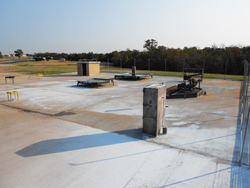
This prop consists of a large liquid pan fire, a three dimensional liquid fire area, a simulated sump area with pumps located on top of grating. Students acquire hands on experience using dry chemical agents to extinguish liquid fires.
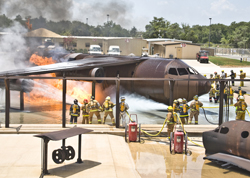
This prop includes a small and a large spill area. The large spill area features a 72-foot fuselage with first class and coach sections, bi-level wings, tail section, and cockpit for integrated fire suppression and rescue drills. The small spill area consists of a small fuselage, wheel/brake assembly, and engine. At 5,400 square feet combined, this prop offers the largest pit fire for training in the United States. It supports the coordinated efforts of monitors, hose lines, and ARFF trucks to knock down, contain, and extinguish fires.
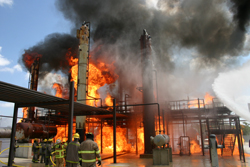
This prop consist of a multi-level structure that simulates a chemical operations fire in order to train the techniques and coordination necessary when using more than one type of extinguishing agent simultaneously on multi-level chemical structure fires. This evolution is designed to resemble process unit with a pump alley, a collection sump, a truck unloading terminal, Aerial Cooler on the ground floor and multiple equipment leak source on the upper deck area. Multiple hose lines are required, using water and foam for fire control, fuel valve isolation, and personnel protection. Dry chemical extinguishers can be used in combination to extinguish isolated fires within the structure. Fixed monitors are located around the project to allow cooling applications. Two remote control fixed monitors are located at this prop to allow participants to have the ability to direct water flows from remote points.
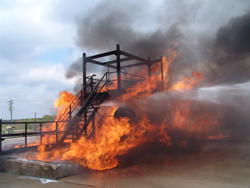
The pipe rack includes a flammable liquid containment area and an elevated walking platform to simulate the typical refinery, chemical process unit, or loading rack/terminal operation with various leak sources such as pump seal leaks and leaking flanges. The pipe rack is conveniently situated between related API projects, to resemble the obstacles typically encountered in real situations, adding to the complexity of any training exercise.
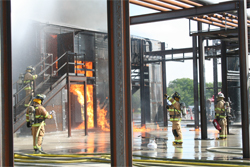
This project simulates a high pressure compressor house with a leaking compressor head and oil drums in an enclosed area. A 50 foot flare stack outside of the compressor house simulates a spill fire at the base of the flare. The entire project is situated within a dike area with electrical transformers, large drums, pumps and control valves located in the area surrounding the compressor house. This project can be utilized as an interior project in the compressor house and will require the use of dry chemical extinguishers for the oil drum and transformer fires.
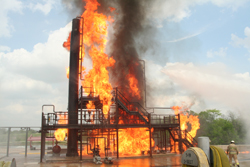
This multi-level structure simulates a chemical operations fire in order to train the techniques and coordination necessary when using more than one type of extinguishing agent simultaneously on multi-level chemical structure fires. Multiple hose lines are required, using water and foam for fire control, fuel valve isolation, and personnel protection. Dry chemical extinguishers can be used in combination to extinguish isolated fires within the structure.
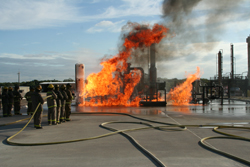
This project simulates a heater skid unit. This area consists of various leak points such as a pump seal leak and a flange leak. There is also a meter loop to provide additional complexity. Adjacent to the heater skid unit is a pump and a condenser that can have multiple leak points. These can be a liquid or Propane gas fire. Participants learn the importance of multiple hose line handling, water pattern techniques, and coordination and teamwork that are
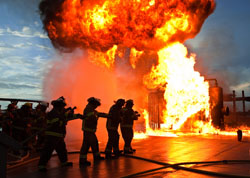
This project involves sets of double pumps that represent seal and flange leaks. A meter loop, simulated compressed air cylinder, and chain-operated valves to operate overhead/elevated flange leaks add to the complexity of this project. Students learn the importance of multiple hose line coordination and teamwork and water pattern techniques that are an integral part of this training.
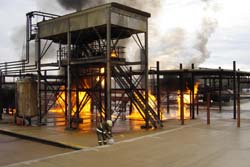
Fueled by a combination of both petroleum gas and E-III, the Aerial Cooler is the world’s largest burn prop. Replicating the structure and equipment found in process units of both the refining and chemical industries, this project includes sets of double pumps simulating various leaks, overhead flange leaks, small aerial cooler tube ruptures, large aerial cooler flange failure, grating-covered drainage trough and various vessels. Teams utilize both water and dry chemicals on both ground and elevated levels.

This project consists of an in-depth spill covering approximately 2,400 square feet, within a loading facility area consisting of multiple elevated storage vessels and pumps with numerous flange and overfill scenarios. The training provides students with a basic understanding of the concepts, hardware and functions necessary to control and extinguish a loading terminal emergency.
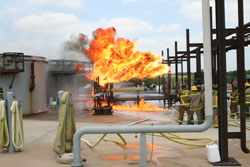
The bulk storage project consists of two 25ft diameter tanks, one being a floating roof tank project with a burning roof seal and the other being a fully involved open top tank simulation. There are also flange leaks at the base of the tanks that can be either pressurized propane or liquid that will form a burning leak spill. Located in close proximity are three sets of pumps and two control valves that can simulate pressure or liquid leaks. Project orientation includes proper tank cooling, foam types, foam application techniques, compatibility of foams, equipment education, foam nozzles and adjustable fog nozzles.
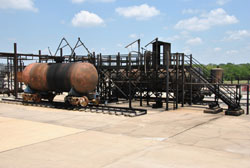
This tank car project is designed to simulate situations that could occur while loading or unloading general-purpose and or a pressure rail car on the loading rack. Fire and spill problems include open dome fires, overfills, loading line leaks, and flange separations. Associated with this project are two sets of pumps with multiple leak sources, which can be liquid or propane gas, and a compressor with a pressurized propane leak. Project orientation includes foam types, foam applications techniques, equipment education, foam nozzles and adjustable fog nozzles. The use of portable and fixed monitors may be used for cooling applications.
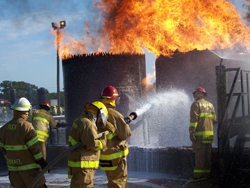
This prop consists of a large liquid pan fire, a three dimensional liquid fire area, a simulated sump area with pumps located on top of grating. Students acquire hands on experience using dry chemical agents to extinguish liquid fires.
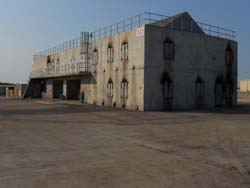
This project utilizes Class A combustibles for all scenarios. This burn complex consists of multiple rooms with doorway for entry and windows for various types of ventilation techniques. This project has exterior as well as interior stairways for access. There is a standpipe and sprinkler system complete with the fire department connection for use in evolutions using a fire truck to support the system. This project provides a live fire situation emphasizing heat and low visibility. Students learn the proper use of equipment, attack methods, approaches, and rescue operations, the use of acceptable procedures and the Incident Command System.
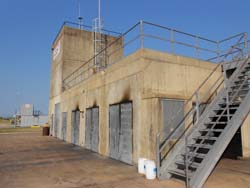
The single story warehouse features multiple rooms separated by fire doors with rack fires to simulate a storage facility fire. It provides a live fire situation emphasizing heat and low visibility. Students learn the proper use of equipment, attack methods, approaches and rescue operations, as well as ventilation techniques, and the use of acceptable procedures.

The three-story complex features a three-story apartment with three rooms downstairs and two rooms on the second floor and two rooms in the attic, multiple closets and external/internal stairs. The commercial side consists of one room down stairs and one room upstairs. There is roof access from both for ventilation and rescue practices that include ladder operations. This project provides a live fire situation emphasizing heat and low visibility. Students learn the proper use of equipment, attack methods, approaches, and rescue operations, as well as ventilation techniques, the use of acceptable procedures and the Incident Command System.
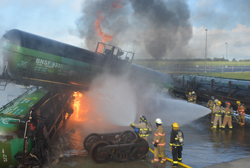
This prop consists of a large liquid pan fire, a three dimensional liquid fire area, a simulated sump area with pumps located on top of grating. Students acquire hands on experience using dry chemical agents to extinguish liquid fires.
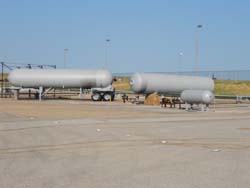
This prop consists of a large liquid pan fire, a three dimensional liquid fire area, a simulated sump area with pumps located on top of grating. Students acquire hands on experience using dry chemical agents to extinguish liquid fires.
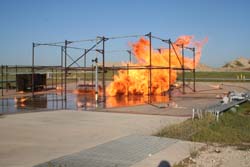
This prop consists of a large liquid pan fire, a three dimensional liquid fire area, a simulated sump area with pumps located on top of grating. Students acquire hands on experience using dry chemical agents to extinguish liquid fires.
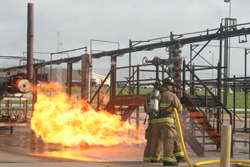
This prop consists of a large liquid pan fire, a three dimensional liquid fire area, a simulated sump area with pumps located on top of grating. Students acquire hands on experience using dry chemical agents to extinguish liquid fires.

The 300-foot ship mock-up is three decks high and encompasses a multitude of enclosed fire simulations. A 175-foot forward deck simulates a typical tanker with numerous live fires: burning barrels, overflowing expansion trunks, manifold fires, confined and unconfined spills on deck, cargo tank fires and simulated electrical fires. The fully enclosed, two-story engine room structure features various hydrocarbon and simulated electrical fires. This prop includes a fire at the boiler front, a broken fuel line on a diesel engine, and a leaking duplex trainer. It also includes a fire at a fuel oil purifier, a fully involved bilge fire and simulated class C fires at an air compressor and electrical distribution panel.
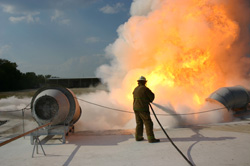
This prop consists of a large liquid pan fire, a three dimensional liquid fire area, a simulated sump area with pumps located on top of grating. Students acquire hands on experience using dry chemical agents to extinguish liquid fires.
